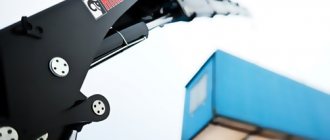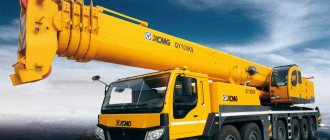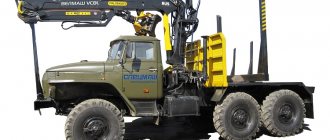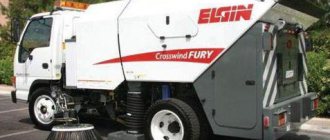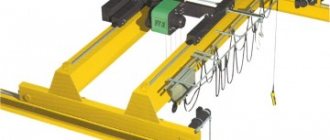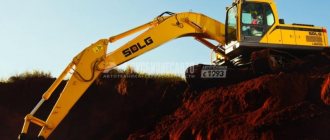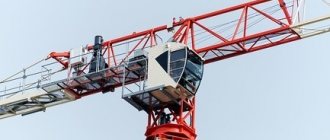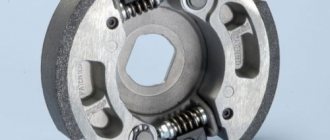Crane manipulators
A loader crane is a machine designed to perform loading and unloading operations and (in most cases) further transportation of goods.
Contents of the review
- 1. What is a crane?
- 2. Operating principles of cranes
- 3. Application
- 4. Replaceable working bodies
- 5. The most important technical characteristics
- 6. Classification by load capacity and load moment
- 7. Boom equipment for manipulator cranes
- 8. Control system
- 9. Outriggers
- 10. Security system
- 11. What can the crane-manipulator installation be placed on?
- 12. Largest manufacturers of loader cranes
- 13. Conclusion
Conclusion: the crane is a technologically complex mechanism that requires increased attention
In order to ensure the safe operation of the loader crane (which is an object of increased danger), all participants in the work process (operator-driver, slingers, loaders) must strictly comply with safety requirements and not violate the operating standards of the mechanism.
And violations of safety regulations do not happen in our company! After all, all specialists regularly undergo relevant training courses and annually take professional aptitude exams.
How else can you entrust the contractor with expensive special equipment and cargo?
Call the manager: Phone: +7 (495) 227-30-10 or send a letter Specialists are available 24 hours a day!
What is a crane?
The main component of the machine is the crane-manipulator unit (abbreviated as CMU), which can be placed on the base of the vehicle or permanently. The mass of the CMU is usually no more than 20-25% of the payload capacity of the base vehicle, which guarantees the effective operation of the latter when delivering goods. The CMU itself is a lifting device, which consists of:
- working boom equipment,
- support frame,
- load-handling device (usually a hook suspension),
- control and security systems.
The introduction of this special equipment into operation makes it possible to significantly simplify loading and unloading by eliminating the use of loaders and reducing the number of special equipment units involved. Combining a base vehicle and a CMU in one vehicle contributes to significant savings in financial and time costs and increases the speed of cargo delivery.
Figure 1. Main components of the crane
KMU, what kind of equipment is this?
A manipulator crane is a special piece of equipment that is a lifting mechanism installed on a vehicle. Due to its versatility, this equipment has several other names - hydraulic manipulator, thief, crane-manipulator, etc.
KMU is an abbreviation that stands for crane-manipulator unit. Structurally, the CMU device is a structure consisting of:
- slewing bearing;
- retractable supports or outriggers;
- main and additional booms, sometimes with an extension (in single file);
- lifting device;
- executive hydraulic cylinders;
- control station, in some cases a remote control is added.
Since crane-manipulator installations are most often placed on a vehicle chassis, they are sometimes confused with a truck crane. However, I would like to draw your attention to the fact that the CMU differs from a truck crane very significantly. These are different types of equipment designed to perform different tasks.
The main differences between a crane and a truck crane:
- Arrow. In the CMU, the first two or three sections (depending on the type of structure) have an elbow connection and only then comes the telescopic part. The truck crane has a telescopic boom starting from the first section.
- Operator's work. The truck crane operator, as a rule, works from a equipped closed cabin, while the crane-manipulator unit is controlled from the ground using levers mounted on the frame or from the remote control.
- Arrow length. As a rule, the reach of the CMU boom is less than that of a truck crane.
- The crane-manipulator does not have a counterweight and its lifting characteristics are determined by the support contour.
The name also hides the principle of operation of the crane unit - the operator manipulates the crane installation. Most often, its drive is carried out from the hydraulic system of the vehicle on which it is mounted. However, this scheme is not always possible. Then the crane can be equipped with its own electric motor.
Operating principles of cranes
The most widely used these days are cranes mounted on a vehicle chassis, the main advantage of which is their versatility. “I load it myself, I drive it myself” - this phrase is the easiest way to describe this car. The vehicle on the basis of which the CMU is mounted essentially performs the functions of two pieces of equipment at once: a truck crane and a vehicle for transporting cargo.
Figure 2. A truck-based crane successfully replaces two vehicles at once
It happens that a truck crane is unable to perform its assigned function due to its large size. In this situation, a crane can also be a worthy alternative.
What cars are manipulators installed on?
Perhaps the most valuable quality of cranes for consumers is their versatility. The lifting device can be installed on almost any model of domestic or foreign truck on a reinforced, specially prepared vehicle frame.
South Korean
- HYUNDAI
- Daewoo
- Kia.
Japanese
- ISUZU
- Mitsubishi
- Nissan
Russian
- KAMAZ
- MAZ
- GAS
- ZIL
- URAL
- YAMZ.
European
- VOLVO
- MAN
- Mercedes
- Renault
- Fiat
- Scani
- HINO
- Iveco
- Peugeot
- Tatra.
Chinese
- BAW
- Dongfeng
- FAW
- Foton
- Xin Kai.
USA
- Ford
- Studebaker
- Freightliner
- Kenworth
- Navistar
- Peterbilt
- Willys.
Application
The machine ideally copes with the mechanization of loading and unloading operations, and therefore can be used for lifting, loading and further transportation of both single objects and cargo located on pallets and pallets, as well as in containers. With the help of these machines, you can successfully transport small-piece cargo, machine tools, change houses, glass, logs and other long items, metal scrap and even cars that are in faulty or emergency condition. In addition, such machines are widely used in the following cases:
- when performing installation and high-altitude work;
- in low-rise construction;
- in public utilities;
- when performing repair and restoration work;
- when carrying out work in cramped conditions.
Replaceable working bodies
Often, replacement equipment is included with cranes. Examples include hydraulic grips for containers and piece goods, grabs, which are in demand when loading small pieces and bulk materials, a cradle for lifting people, grips for rolls, fork lifts for pallets, load grips for curbstones and many others. etc.
Figure 3. The modern market offers a wide range of replaceable working bodies for manipulator cranes
Advantages of CMU
Using a vehicle with a CMU is more profitable and simpler than using a separate truck and a separate crane. Pure mathematics: two vehicles cost more than one. A vehicle with a crane has other advantages:
- Mobility. Special equipment, especially its compact types, moves freely around the city.
- Reliability. When properly controlled, a vehicle with a CMU operates reliably and copes with many tasks.
- Multitasking. Special equipment is capable of performing many different tasks needed for construction and other industries.
The most important technical characteristics
The areas of use and cost of different models of loader cranes depend on the following indicators characterizing this equipment:
- minimum and maximum values of the CMU boom outreach;
- load capacity at minimum and maximum values of the CMU boom outreach;
- load moment of the boom at the same radius parameters;
- height of lowering and lifting the load;
- suspension type;
- the minimum possible turning radius of the CMU;
- type of cross section of the arrow (the greater the number of edges, the stronger the arrow will be);
- a type of telescopic extension system (boom sections can be extended sequentially or in random order).
For manipulators made on the basis of a cargo vehicle, important operational indicators are the load capacity of the base vehicle, the dimensions of the loading platform (the maximum dimensions of the transported cargo directly depend on them), the outriggers (supports) used, the quality of workmanship and type of which have a significant impact on the maximum weight of the cargo , lifted using the CMU, and the safety of the latter.
When considering the possibility of purchasing or renting a particular model of loader crane, you should familiarize yourself with its load-height diagram (an example is shown in the figure below), which clearly demonstrates all the capabilities of the lifting installation, allowing the potential buyer (user) to obtain its most adequate assessment based on the totality of the parameters discussed above .
Figure 4. An example of a load-height diagram for a crane-manipulator model LV 220-01
Classification by load capacity and load moment
Depending on the load capacity, CMUs are conventionally divided into the following 3 classes:
- up to 1 ton (this class includes machines called micromanipulator cranes);
- from 1 to 10 tons (medium-capacity cranes);
- more than 10 tons (heavy cranes).
Figure 5. The actual maximum weight of the lifted load depends on the reach of the crane boom
However, lifting capacity is somewhat a subjective indicator, since its value does not reflect the dependence of the actual maximum weight of the load being lifted on the boom reach. Therefore, it would be more correct to talk about the cargo moment. This parameter is the product of two factors: boom radius and CMU load capacity. The units of measurement for this indicator are kNm (kilonewton per meter) and tm (ton per meter). As such, there is no generally accepted classification of CMU for this parameter. For this reason, you can rely on the experience of enterprise developers. For example, the Austrian manufacturer Palfinger classifies its own machines into 3 groups:
- light class (load moment no more than 3.9 tm);
- middle class (load torque ranging from 4 to 29.9 tm);
- heavy class (load moment in the range from 30 to 150 tm).
A different classification of CMU models is offered by the Swedish manufacturer of special equipment HIAB, dividing its machines as follows:
- light class (load moment less than 10 tm);
- middle class (load moment from 10 to 22 tm);
- heavy class (load moment – 22 tm or more).
Did you know that CMU can also be found in space?
I'm not kidding! Since 1981, cranes have been operating on the ISS. They carry out loading operations both inside the stations and in airless space, and also help assemble the necessary parts of the ISS itself. The cosmonauts themselves sometimes act as their cargo, because CMUs often help them move outside the spacecraft!
Space manipulators, of course, look different from their terrestrial “colleagues”: some installations look like robots, some move in steps, some are attached directly to stations and ships.
The most powerful space CMU can lift 116 tons with a length of over 17 meters. This American development, called Canadarm-2, was released in 2001 and still serves faithfully in orbit, despite the fact that this spring a piece of space debris got into the installation.
Russia also has something to boast about. The domestically produced telescopic crane "Strela" first functioned at the Mir station, and is now used on the ISS. With a length of 15 meters, it can effortlessly move cargo throughout the Russian segment of the international space station.
In the Soviet years, outstanding designers created an entire system of onboard manipulators, consisting of several cranes and controlled both from the Earth and from space. The system was called “Stork” and was supposed to fly in 1991, but for obvious reasons this did not happen.
Read also: How are they launched into space?
Boom equipment crane-manipulators
Depending on the type of suspension used, cranes with boom equipment are distinguished with a hinged (rigid suspension) and rope (flexible suspension) design. In the case of a flexible suspension, the load is captured using a load hook, which is located at the end of the winch. Well, the rigid suspension provides for the hinged placement of the hook on the boom head.
Depending on the type of folding, CMU boom equipment is divided into 2 types:
Being folded for cargo transportation, the KMU boom equipment is shaped like the corresponding letters of the English alphabet.
Z-boom cranes
The Z-shaped boom shape is typical for loader cranes produced under many European brands. Often this design is called “cranked” or articulated. In this case, the boom equipment is folded into several bends. On a cargo vehicle, the CMU of this type can be installed behind the driver’s cab or on the rear overhang of the body. During the transportation of cargo, this structure is located across the frame of the base vehicle.
Figure 6. Model SQ16ZK4Q crane with Z-type boom
The main advantage of Z-type boom equipment is its small size. During the delivery of goods by a vehicle with such a CMU, the working volume of the body is used as fully as possible. Thanks to the use of several elbows, these installations make it possible to deliver certain cargoes to various hard-to-reach places, overcoming obstacles, for example, to the floors of buildings under construction.
This design also has its drawbacks. These include: the possibility of significant overload of the front axle of the vehicle (if the CMU is mounted behind the driver's cabin of the base vehicle), the need to use a powerful and, accordingly, expensive chassis, as well as the difficulty of loading and unloading work in close proximity to the crane column ( To fold and unfold the boom equipment, sufficient free space must be cleared around the CMU).
However, thanks to the ability to use a wide variety of attachments, articulated cranes are capable of solving a huge number of different tasks. The maximum efficiency of their use is achieved when performing work with large loads and solving various special tasks.
L-boom cranes
L-shaped boom equipment has become widespread on loader cranes produced by manufacturers from Japan, South Korea and North America. In this case, the CMU is equipped with a straight telescopic boom and a rope suspension of the hook. When installed on the base of a cargo vehicle, the main part of the CMU in the folded state is installed above the body (along the frame of the vehicle) or the driver’s cabin. When choosing L-shaped boom equipment, you should pay special attention to the operational parameters of the winch installed on it.
Figure 7. L-boom crane in operation
The main advantages of using L-boom cranes are:
- partial redistribution of the weight of the hydraulic unit onto the rear axle of the base vehicle, reducing the likelihood of overloading the front axle;
- higher productivity compared to Z-shaped structures in the case of lifting and lowering loads at high boom radii (up to 6-8 meters);
- higher precision of work, ensured by the use of a cable suspension of the hook, which allows the load to be moved along a straight path, without deviations.
The disadvantages of L-shaped CMUs include:
- restrictions imposed on the transportation of high loads in the body and loading of bulk materials “with a slide” (when the CMU equipment is located above the body);
- impossibility of performing work if there are any obstacles to the free movement of the boom.
The most appropriate use of cranes with L-shaped boom equipment is when carrying out work with heavy but compact loads.
Control system
The control system in machines of this type is usually represented by a set of levers, each of which is responsible for a specific action, be it raising the boom, extending outriggers, raising or lowering the cable, etc. Often the controls are located at the base of the boom on both sides of the base of the CMU .
However, it is not uncommon for manufacturers to place these arms at the top of the boom base where the operator's seat is located. Models of cranes produced today are often equipped with remote control panels that allow you to control the operation of the cranes from a distance.
Figure 8. Crane control system
Outriggers
Outriggers are retractable supports that are installed on the ground during loading and unloading operations, thereby ensuring the necessary stability of the base machine. Loader cranes use outriggers that differ in the method of extension, which can be mechanical or hydraulic.
In the first case, the outriggers are extended manually. After installation on the ground, the outriggers are fixed in the desired position.
The hydraulic method of extending outriggers involves the use of compact hydraulic cylinders driven by a hydraulic motor of a manipulator crane. Outriggers of this type are equipped with cranes with high lifting capacity.
Main types of CMU
Vehicles with a crane-manipulator installation are divided into the following types:
- Hydraulic manipulators. The weight of such special equipment is insignificant, the maintenance system is simplified, which ensures ease of operation. The carrying capacity of this type is small: up to 7 tons. Maneuverability at a high level. Hydraulic manipulators are used for transporting building materials, installing slabs and floors.
- Medium weight manipulators. The minimum load capacity of such models is 25 tons, and the maximum is 80 tons. The boom reach can reach 20 meters. The CMU is installed on a platform, which is a truck whose weight is medium or large.
- Hydraulic manipulators. This is the newest and most durable modification of a vehicle with a CMU. The models are distinguished by their support on a single-knee boom, which gives them the ability to lift heavier loads compared to vehicles with a double-knee boom.
order a manipulator in St. Petersburg by phone, chat with our manager, or simply leave a request for a call back.
What can a crane-manipulator installation be placed on?
The choice of the type of chassis on which the CMU is placed depends on where the equipment is planned to be used and what tasks are intended to be solved with its help. The following types of cranes are available on the modern market:
- pneumatic;
- on a special automobile chassis;
- tracked;
- with short wheelbase;
- based on a caterpillar or wheeled tractor;
- rail (mounted on a support platform that moves along rails on wheels);
- adjustable;
- mounted permanently on a foundation (for example, on a technological site);
- placed on boats, floating platforms, etc.
Figure 9. Loader cranes with different chassis look very different from each other
In the vast majority of cases, vehicle-based cranes have an on-board platform without an awning, since otherwise the loading procedure using a crane is not possible.
Figure 10. A truck with a CMU and an onboard platform without a tarpaulin - this is what a typical representative of loader cranes looks like
The largest manufacturers of cranes
To date, the crane market can offer customers both domestic and foreign models. The production of special equipment of this type is carried out by a number of Russian companies, CJSC Inman, VELMASH-S, the previously mentioned companies HIAB and Palfinger, the Italian supplier Amco Veba, the Japanese company UNIC and many others. etc.
Compact cranes with low dead weight are produced by BAKM CJSC, whose production base is located in Balashikha (Moscow region). A manufacturer from Bashkortostan, Inman CJSC, supplies the market with a wide variety of models of loader cranes with Z-shaped boom equipment. When assembling the CMU, imported components are widely used (from Swedish, Italian, Finnish suppliers). Increased rigidity of the arrows is ensured by the use of a durable hexagonal profile in their manufacture.
The Swedish company HIAB, one of the world leaders in the production of loader cranes, offers customers a huge range of cranes with a load moment from 1 to 80 tm and a maximum boom radius from 2 to 27 m. All installations have a wide range of operating temperatures (from - 40 ° C to +50°C).
The well-known Italian company Amco Veba produces 3 series of cranes: “Standard” (universal models), “C” (installations with a reverse boom) and “E” (machines of a simplified design). The manufacturer pays great attention to the safety of its products, which is reflected in the slogan.
CMUs manufactured under the UNIC brand are supplied to more than one hundred countries around the world. This equipment is distinguished by traditionally high manufacturing precision for Japanese products, while maintaining productivity and load capacity at the level of the best European models of crane units.
